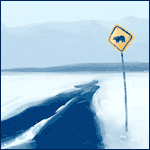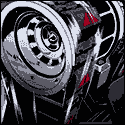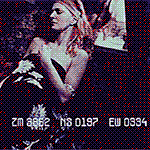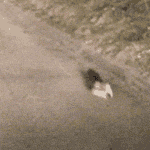|
Exactly what the thread says, tell me about terms in your little niche that haven't broken through. In the action figure/Barbie collector world, there's a term - MOC - meaning Mint On Card, the best possible condition a figure can be in. Or in the Disney Weirdos world, AFOD is "Adult Fan of Disney" What are your weird subculture's jargon and terminology that hasn't made it out of your subculture. For clarification, something like "tilt" that started in Poker but is now just kind of generically widely used to mean 'upset and emotional based on past events' wouldn't really apply, since it's made the jump to general usage. I'm looking for the stuff that's still just in your little subculture.
|
|
|
|

|
| # ? May 8, 2024 21:22 |
|
"You failed the 10% rule" 10% Rule: You must be 10% smarter than whatever you are working with. OOB- Out of Battery, normally followed with the word 'detonation'. Used in reference to guns, were the gun does not fully lock into battery
|
|
|
|
If we're including work poo poo: OOC: Out Of Code, as in out of date, unsaleable product. If you've left 'codes, you've done hosed up or gotten lazy. Handheld: a hand held (duh) computer used in inventory tracking and to generate invoices. Milk-hook: a three foot long blunt hook with a T handle on top, used to grab the bottom of a stack of milk crates or plastic trays while pulling from the top with your other hand. Most are fifth-wheel pin-pullers, used to engage/disengage the pin on a 5th wheel trailer turntable. Seriously, buy one. They come in handy for a bunch of things. Saves the back and shoulders.
|
|
|
|
Shrecknet posted:For clarification, something like "tilt" that started in Poker but is now just kind of generically widely used to mean 'upset and emotional based on past events' wouldn't really apply, since it's made the jump to general usage. I'm looking for the stuff that's still just in your little subculture. i've never heard it used to mean that outside of poker. ive heard it much more commonly used in the context of pinball, in which case it refers to a sensor in a pinball machine designed to stop players from physically shaking or moving it. but then, obviously, i am old.
|
|
|
|
Earwicker posted:i've never heard it used to mean that outside of poker. Mathematics obviously has some terms for some technical things, but there is also jargon for basic/everyday concepts (or jargon changing the meaning of every day words). "Upstairs"/"downstairs" referring to things above and below in a diagram or on a chalkboard. "Kill" to mean "make become zero". "Algebra" to mean an advanced field of math studied almost exclusively by math majors, rather than everyday/high school algebra. "Elementary" to mean something like "only using methods available to mathematicians 300+ years ago", rather than elementary school level.
|
|
|
|
On a set of signed, sealed, and city-permitted apartment plans that I was looking at the other day, a 4 inch diameter toilet drain was called out as a "TURD PIPE". Which gave me a good chuckle. I've seen slang become professional jargon in real time, apparently.
|
|
|
|
Shrecknet posted:Exactly what the thread says, tell me about terms in your little niche that haven't broken through. In my subculture (house squatters and punk rockers from the 80s), tilt is taken from the literal meaning in our language "to topple, upend or turn over", and taken to mean destroy, beat up or defeat. "We'll tilt the mayor's office" was an often used turn of phrase.
|
|
|
|
I say "hella" a lot. Its NoCal slang but im SoCal. Real deep south SoCal so i decided im taking it from those northern dipshits! Hella tight yo
|
|
|
|
Feedwater banana
|
|
|
|
Shrecknet posted:For clarification, something like "tilt" that started in Poker but is now just kind of generically widely used to mean 'upset and emotional based on past events' wouldn't really apply, since it's made the jump to general usage. I'm looking for the stuff that's still just in your little subculture. I'm not even sure tilt originally came from poker - I think it originated from pinball.
|
|
|
|
https://en.wikipedia.org/wiki/Baker_percentage
|
|
|
|
From programming/software engineering Overload/overloading/overloaded: a feature of a programming language that allows more than one valid definition of the same name in certain situations. Sometimes used by analogy to mean words in a natural language that have more than one definition. Cycles: sort of the basic unit of time within a CPU (it's complicated). Used by analogy to mean a person's capacity for work. E.g. "Do you have spare cycles to do this?"
|
|
|
|
I see this on a lot of large transformers. They are delivered by rail, and it means do not transfer the rail car by pushing it over a hump.
|
|
|
|
Buttchocks posted:I see this on a lot of large transformers. They are delivered by rail, and it means do not transfer the rail car by pushing it over a hump. lol, probably good advice either way!
|
|
|
|
At my last job, if something broke or wasn't reading correctly we'd yell "Nerts it!" Nerts was a pronunciation of NRTS which stands for Not Repairable This Station. If the item was too obsolete, too costly to repair, or if we weren't authorized to repair we'd give it back to the end user and tell them to dispose of it. We'd take a NRTS action code in our database (0-9) and throw some green or red tags on it and send it out the door.
|
|
|
|
"Cullet" was a term used when I worked at a glass factory. It referred to the "Cullet Pile" that existed on the lowest level of the factory. Essentially any time glass product was broken on the production line or warehouse they just scooped it up moved it back to the furnace and melted in back down into more glass. They had that word "cullet" stenciled on the forklift/bulldozer machines that ran around the factory scooping it up. I had access to an unabridged dictionary that did not list that word. Now that the internet exists I can see that it is a real word, but it was not in 1992.
|
|
|
|
In the oil and gas industry I would hear the term "tower" to refer to a workers shift. So if you worked 12 hour towers that would be a 12 hour shift. I don't know why. Maybe they got confused with the word "tour"?
|
|
|
|
|
In cryptography, a nonce is a number that’s used only once (number once) as part of some authentication and encryption methods.
|
|
|
|
dirby posted:It's used in other competitive games (maybe especially when played online?) now. Like Chess or League of Legends. nice, i have a Math degree too but I'm stuck in a room full of high school kids "pieces of poo poo" - the kids "the possible school shooter i'm always watching" - the weird kid in the back "any other career available, please lord, anything" - the classified section in the newspaper
|
|
|
|
in semiconductor manufacturing - OOP. Stands for Out Of Pocket in relationship to a silicon wafer. Whenever internal wafer handling robotics mess up and wafer is placed anywhere other than its designated position inside the tool (a.k.a pocket). The internal sensors detect this condition, stop the automated sequencer, and alarm out the tool.
|
|
|
|
Oh boy, I could write a book on all of the nonsense jargon we use in Lean Six Sigma. Here are a few good ones, due to most of the procedures being developed in Japan they're typically Japanese terms: The 3Ms of Mura, Muri, and Muda. Mura is something inconsistent, Muri is something excessive or unreasonable, Muda is something that wastes resources. These can be expanded on with 7 different kinds of wastes, things like having common tools far away from each other which wastes time and energy to have to walk between them. People in the industry get obsessed with these kinds of wastes, to the point where they'll analyze a break room and complain that the refrigerator is too far from the coffee machine as most people will want to add milk to their coffee. 5S is another fun one. They also have Japanese names but can be stated as Sort, Set, Shine, Standardize, and Sustain. Essentially rules to create a clean workplace where there is nothing unneeded in the workspace. So, you'll never see anyone with pictures or plants on someones desk, those are unnecessary distractions and just get in the way to getting work done! There's also something called Kanban, which is confusing because there's also something called Kanban in Agile which is a different kind of methodology. The Agile version is like a work in progress board, whereas the lean version is kind of the opposite, where you work from the end point of a process to the beginning. The later stages tell the earlier stages what they need to complete a task, either by passing them a physical card, or doing it digitally. The idea is to eliminate overproduction. We also have non-Japanese terms like a Gage R&R which is an incredibly tedious process of testing equipment accuracy. This isn't even scratching the surface! I'm pretty sure I could copy an average industry email and very few people would understand what the content is about.
|
|
|
|
Teacher here. ICQ - Instructional checking questions. Questions you ask to make sure your students understood your directions and will proceed when you say to. Things like "Are we opening to page 40 or 14?" CCQ - Concept checking questions. You ask these to make sure students are coming to grips with the material. They're used to gauge whether the majority of the class is ready to move on to the next part of the lesson. Scaffolding - Context and support provided by the teacher to help students complete a task. The further students are from being able to complete the task on their own, the more scaffolding they'll need. It could be a word bank, or a list of relevant formulas, or completed examples for them to model their work on. Loads more, but those get used on a daily basis.
|
|
|
|
Pharmaceutical: MA - marketing authorisation (basically a licence to sell a specific SKU in a specific country) MAH - MA holder (the entity holding the MA) Rx product - a licenced drug requiring a prescription OTC Product - Over the Counter - can be sold without prescription API - Active Pharmaceutical Ingredient (i.e. the thing that actually makes the drug achieve its intended medicinal effect) GMP - Good Manufacturing Practice; a system for ensuring that products are consistently produced and controlled according to quality standards GDP - Good Distribution Practice; a set of standards for the sourcing, handling, storage, and transportation of medicines WDA - Wholesale Distribution Authorisation; general licence to sell and market pharmaceutical products RP - Responsible Person; named on the WDA and responsible for adherence to the licence conditions and to GDP standards QP - Qualified Person; responsible for certifying batches of medicinal products before they’re used in clinical trials or put out on the market Adverse Event - any untoward medical occurrence after taking a medicine. May or may not be causally linked PV - Pharmacovigilance; a system which records all adverse events for a drug. It is a legal requirement for all pharmaceutical companies to record these for all products
|
|
|
|
Beer Leg - When surveying with a measuring chain, to set up the theodolite so one tripod leg points directly down a line you're planning to measure. When you try and use the chain, the leg will be in the way and you owe the rest of the crew a beer. Died with measuring chains (i.e. the late 90's)
|
|
|
|
If you kick the tripod and have to reset and shoot your backsite again it's still a beer. Still alive!
|
|
|
|
|
Lol, thankfully none of my chainies haven cottoned on to that one. I buy them lunch if they manage to eye in a peg with no corrections required though.
|
|
|
|
cwinkle posted:They had that word "cullet" stenciled on the forklift/bulldozer machines that ran around the factory scooping it up. I had access to an unabridged dictionary that did not list that word. Now that the internet exists I can see that it is a real word, but it was not in 1992. Did they just bastardize the phrase "cull it"?
|
|
|
|
Miniature sculpting and production has some okay jargon. Green: term used for a master sculpt, taken from the bright green Kneaditite epoxy commonly used to sculpt miniatures. Cork: any handle used to hold a mini when sculpting. Used to be primarily corks, now a lot of folks use wooden blocks. Heroic 28/Heroic 32: Specific scale and proportions for miniatures that fit into the range with stuff made by Games Workshop/Citadel. Specifically, 5.5 heads tall, oversized hands, and eyes positioned a bit higher on the face than normal. Wax: Refers to a specific tool, the Wax #5, that a lot of sculptors use. Dolly: Any premade armature with some bulk to it, rather than just using wire like a normal person. Marvel Scale: 40mm to the eyes, regular human proportions (7-8 heads). Slotta: The little strip with the company or sculptor’s name that’s usually attached at the base. Also called a strip, tab, or signature block. Pokey: Any tool made from a needle, usually used to poke small details. Greenbash: Reusing a previously-cast green after removing parts, reposing it, or otherwise getting “new” models from an already finished model. Really common in the older days, especially when a small company needed to bulk out a range. Garage: Any casts or limited releases where they’re made by a small, single-person shop or in limited release. 9”: dimensions of a circular spincasting mold, made with vulcanized rubber. 12” were also common, and sprue layout needed to be balanced in the mold and designed so that you’re getting an appropriate amount or type of model. Spins: A single casting cycle for a single mold. Frequently used with price sheets by casting foundries. Mixed Mold: Any mold that doesn’t just give copies of a single part or model, but rather multiple. Split Mold: A model that requires more than one mold to produce all of its components. Inked Master: An early, high-detail cast taken either from the master mold or from the first production molds that is carefully cleaned and then has ink added to the recesses to make the detail more apparent. This is used in stock catalog photographs for stuff like suppliers as well as internet storefront images, usually to supplement a painted model so people can see what they’re buying.
|
|
|
|
I've worked animation and video games, though I've mostly been illustrating these last few years (yes, even for furries, they pay decent). Idk if any of these get used in other industries. These are also mostly for 2d work. I do not do 3d well, any work I've had in the video game sphere has been sprite based. Pipeline- short for production pipeline. Key frames- the strongest poses of an animation. The most important, where the big motions are heading. Tweens- short for in-betweens, which are the frames that are, well, in between the key frames. Despite what you might think, these are still incredibly important. Timing- and this is why in-betweens are incredibly important. We've all seen animations that either moved too fast or too slow, or caught in a weird way, or didn't match to sounds right. This is because of bad timing, which is using too many or too few frames on something. Timing is something that is very difficult to teach- there are graphs called timing sheets to keep it all in order, but, frankly, I've had the best successes when I do it by intuition. Timing is also used interchangeably with the term frames per second, but it intersects in a weird way. You see, as well as base fps, with animation you also decide how long each frame is shown. When I was trained, it was common that most animations were shot on twos at baseline. So, the format for American TV was 30 fps at the time. If I were working in tv animation, and animating on twos, I would be making 15 drawings for a single second of animation. If I were working on a film animation, it would be 12, as 24fps was standard. One can animate on ones, that is a full 24 or 30 drawings for a single second (the flies on the thief in the Thief and the Cobbler were famously so) but that will result in a different look for your work. A lot of the time, utilizing the mentioned timing sheets, how long a frame is shown would be adjusted. So you might be doing most of the work on twos, then drop to ones for a few frames to emphasize something, then go back to twos, etc. I can usually tell where a studio is loving with timing, and have great appreciation for this art- it is the hardest part of the work, in my opinion, not keyframes. I can bust out keys like nothing, but the meticulous nature of tweening can make me pull my hair out. Secondary motion- also called "secondary animation", it is the miscellaneous things that happen during movement- a character's hair moving around as they gesticulate, the bob of a necklace on their neck while they run, etc. Bluth's works famously offer quite a lot of this, sometimes to the point of being too much in the opinion of some (not me). Symbol- in vector animation programs, starting with Flash, drawings could be turned into "symbols". These can just be static images you want to hold onto, or you can actually just make a symbol hold a full animation of it. Animating a set of eyes that blink in a natural way, so that you can focus on matching the lip sync instead of making the same blink over and over. You can nest them, as well, putting symbols in symbols, which is common. Path- you can put symbols on paths to move them, sort of an automatic animation, but it must be highly finessed or it looks like cheap rear end. Autotweening- remember that massive timing tangent? Yeah, they said they can just automate that for you! It usually looks like hell, but yeah! Okok, I'll stop acting like an old man for five seconds, these days autotweening and path use is really sophisticated, and looks way better than it ever did! In the hands of a master, even I have trouble catching it, and it saves time for when things need to be handled frame-by-frame (term for non-automated animation), allowing animators to polish it up better. Bad use of autotweens results in that "flash" look you'll remember if you ever did any time on newgrounds.
|
|
|
|
Catering to perverts, I feel like the "tween" jargon is particularly dangerous. Do you have any "fun" (i.e disastrous) stories where that jargon bit you or anyone you know (even if it is apocryphal) running into trouble with that?
|
|
|
|
I have one that sometimes rubs people the wrong way. I work in electronics, so we talk a lot about transformers. Shorthand in for 'transformer/transformator' is 'trafo' in my language. An old 1970s-80s shorthand, almost slur for 'transvestite/travestiet' (itself not being a very appropriate word anymore) in my language is 'travo'. Travo and trafo sound exactly the same, and very occasionally someone thinks we're using coarse language talking about crossdressers. And occasionally someone less proficient in the dutch language writes 'travo' when talking about transformers. But in the end, no one thinks it's too big of a deal, probably because the last 2 generations have never even heard the word 'travo' being used as a slur. The mostly USA shorthand for transmission (as in a car's transmission) is sometimes 'tranny' but i get the idea that that one is more often used as 'hur hur transsexuals amirite' and some transgender folks who work on cars have actually asked if people could stop using that word. For more risqué or outright insulting jargon, i think you should jump into one of the military threads. Or at least back in the early 2010s when i first lurked SA, they were pretty bad for that kind of stuff. LimaBiker fucked around with this message at 12:58 on Aug 21, 2022 |
|
|
|
LimaBiker posted:I have one that sometimes rubs people the wrong way. I work in electronics, so we talk a lot about transformers. Shorthand in for 'transformer/transformator' is 'trafo' in my language. We also say "trafo" in Swedish
|
|
|
|
An irritating one from the horsey world is that 'event' and 'show' have specialised meanings, in that 'eventing' is a sport where you compete in three ridden disciplines (dressage, cross-country, and showjumping) and then your combined score determines the outcome. It used to be called 'horse trials' sometimes. 'Showing' is where the horse is being judged on its type rather than its ability, it might be ridden around in a circle or just led up and down by a handler. I'm not really interested in this side of things, but if I'm talking to a normal person I'll just say "I'm going to a horse show this weekend" rather than "I'm going to an event" because it avoids the who's-on-first 'what kind of event?' conversation. ('Horse trials' gets "why, what are they accused of?" because people are hilarious.)
|
|
|
Atlas Hugged posted:Teacher here. Education is second only to military in terms of how many freaking acronyms get invented.
|
|
|
|
|
LimaBiker posted:I have one that sometimes rubs people the wrong way. 'Biner - short for carabiner, and yeah, pronounced how you think Some others: Bomber - an adjective to describe an anchor or feature that is extremely solid and immovable ("the bolts on that second pitch are sketch and need backup, but the next ones are bomber") BFT or BFR - Big loving Tree or Big loving Rock, aka a good place to build an anchor Pro - short for protection, mechanical gear like nuts or cams placed on a climb to provide anchors. Installing it is "adding pro" or "placing pro", removing it is "pulling pro" The Pig - the haul bag (duffel bag) of gear like hammocks and food and stuff that big wall climbers bring along and haul up with ropes after climbing to the start of the next pitch. Also heard this one called "The Baby" Lamar - "Last Man At Risk", the last member of your party who is either climbing up and pulling pro or rappelling down Abseil - a synonym for rappel that only Europeans use Beta - published information on a route, usually including details like access, difficulty, required gear, etc. Take a whip - falling when lead climbing, which usually means you swing on the rope like a pendulum and whip into the rock face Approach - foot access to the spot you're climbing at, all the traveling you have to do until you get to the wall Boil - the bubbly splash zone of a waterfall. If jumping from the cliff, you're going to sink much deeper in the aerated boil than in the other water Ghost - to complete a route leaving no permanent protection behind (like drilled in bolts) or even webbing for anchor construction
|
|
|
|
2nd Amendment posted:Catering to perverts, I feel like the "tween" jargon is particularly dangerous. Do you have any "fun" (i.e disastrous) stories where that jargon bit you or anyone you know (even if it is apocryphal) running into trouble with that? I'm sorry to disappoint, but I actually don't! The only time, in my experience, that there's been trouble is just confusion, or when the demographic comes up in discussion. To be fair, most of us tend to only discuss shop with people who want to- I've seen that glazed expression enough to curtail conversation regarding technicals. "Autotweened tween drama" would be a cute name for a Steven Universe knockoff, though! Some general art terms, some which might be known and some aren't, as I realized I didn't explain some things, thinking maybe a forum well known for photoshops might just know: Vector- in digital 2d, this refers to a type of image processing that is entirely resolution independent . This means that it can be resized and changed with no loss of resolution or sharpness, and no fragmenting. This is because the lines are made up of math calculations to create the curves and stuff! Adobe Flash/Animate is a vector program, as is Illustrator! These programs have a huge learning curve, because it isn't at all like just picking up a tablet and doodling. Free advice is that, should you get a logo made, get it done in vectors. Then, you don't have to worry when you inevitably have to resize it to put it on things. Raster- raster files are your regular .pngs, .jpgs, etc. They are resolution dependent and get the artifacts and such that they're known for upon resizing. Tech for resizing has gotten way better, CSP in particular actually does really well, and has several ways of mitigation, but there's going to be a limit. Free advice, for this, as well: going down in size hurts less than going up. If you need to make something but aren't sure on size, create a too big image rather than too small. Refractive lighting- also known as rim lighting. You know that cool little sliver of light on the edge of a surface, right on the darkest point? It sets it off, usually reflecting off whatever the object is on? There you go. It drives me a bit crazy to call it "rim lighting" because I actually do have a story where a guy wouldn't stop calling it "rimming" and I slowly died. Normals- "normal mapping", this is from 3d. Everyone knows what s bump map is, a normal map is somewhat similar, and does a similar function. Rigging- it means the same in 2d and 3d these days (though puppet rigged stiff in 2d can still be stiff), you're "rigging up" a character like a puppet, giving them "bones" and "joints" to move. You'll call the apparatus a "rig" as a whole. Rigging is both a noun and a verb. The best model on a bad rig will still yield bad work. Modeling- creating a 3d model. Sometimes, I forget that human models exist, and tell someone my wife is modeling and get a weird reaction before I explain she's building 3d models, not strutting on a runway. (I mean, she's tall enough to, lol Nurb- I don't actually know if these are still used. They're the 3d equivalent of vectors- 3d curves made on a sort of math calculation different than vectors. They used to be the only way to get truly smooth objects, and a lot of that early ultra-smooth and round 3d was made of them. But these days polies are so cheap and plentiful, idk if people even bother anymore. Ray Tracing- it is hilarious to me that this is just now on everyone's tongue in gaming, as it has been a thing in animation forever. It's also fascinating that we have gotten to a point that it is possible to have something ray traced in real time in a game. I do not like, however, to see things I think of as in "my house" to become a buzzword. Fun animation fact: in Reboot, a lot of the characters were named after computer terms (Megabyte, etc.), which is well known. But before I got into animation, I never realized that Phong was named after a 3d shader!
|
|
|
|
DicktheCat posted:Nurb- I don't actually know if these are still used. They're the 3d equivalent of vectors- 3d curves made on a sort of math calculation different than vectors. They used to be the only way to get truly smooth objects, and a lot of that early ultra-smooth and round 3d was made of them. But these days polies are so cheap and plentiful, idk if people even bother anymore. From packaging: Cardboard: this stuff does not exist. Everything is made from paper, so you have heavy paper, paperboard, etc. "Cardboard boxes" are "corrugated paperboard" Corrugate: the bit of folded paper between the flat parts consumers normally touch. Also refers to the bulk product. Flat or Slip: A piece of corrugate before it's cut and scored to make a carton blank. Think 48x48" (or larger) sheet of flat corrugate. Carton: something made of paper that you can fold to make a container for something else. Case: something made of corrugate that cartons go in, usually for shipment to another place. When Wal-Mart buys cereal, they buy cases of cartons. The cases are all on a pallet when they're delivered to the store. The people who stock the shelves take the cartons out of the cases and put those on the shelves. Packaging: A way to keep food from touching the air to keep it from spoiling. Again with the cereal box: There's the outer carton then the inner bag. With the graphics that goes on the carton, a way to seal it all up, and the regulatory information required, these comprise the packaging. Sealing: A way to keep packages, cartons, and cases from falling apart or unfolding. There's a whole universe of glues, tapes, and heat-sealing plastics here. CPG: Consumer Packaged Goods. A complete product, with bar code, designed for an individual consumer to purchase. If you're buying cereal in a store, that's CPG. If you're getting a candy bar in a convenience store, then the CPG is the wrapped bar itself is the product, with the paper displaying box a set of bars comes in being considered the "packaged good." This can get pretty complicated. The displays at Home Depot you see out in the aisles are assembled by the manufacturer and shipped to the Home Depot. The stockers then "commission" the display by pulling off an outer case layer to make a pre-assembled display. In this case, the display is considered the CPG, but the outer part of the case isn't (strictly) packaging; it's just a shipping container, considered the same as shrink wrap or pallets.
|
|
|
|
canyoneer posted:
That's one we use in hiking as well, but for the approach to the base of the mountain before the hiking gets steep. A few of the others I would use: Talus: A field of boulders, but not freaking huge ones Scree: A field of smaller boulders, anything from gravel size to about head size Bushwhacking: Going off-trail through bushes, shrubs, and whatever else to get somewhere. Generally frowned upon Glissading: Sliding down a snow field on your butt Postholing: Stepping on snow and sinking down to your knee or deeper Cairn: A stack of rocks either to mark as an unofficial route guide or commonly found at the top of mountains. If you see one anywhere else, knock it over Bivy: Emergency shelter, generally no more than a thin waterproof layer to cover yourself in case poo poo gets real and you have to spend the night outdoors Knife-Edge: The top of a ridge with steep drop offs on both sides Exposure: If a trail has a steep drop on one side, we'd say it was exposed. So if someone is on a knife edge, we'd say the trail has a ton of exposure Saddle: Low point between two higher points, typically where a trail would pass over Scramble: Traveling up rocky terrain with no official trail, potentially using hands a little (Class III) or a ton with exposure (Class IV) Cache: Either a water or food supply that was hidden ahead of time
|
|
|
|
Hotel Kpro posted:Cairn: A stack of rocks either to mark as an unofficial route guide or commonly found at the top of mountains. If you see one anywhere else, knock it over But what if it's a long-forgotten, lonely cairn of stones? Left by someone seeking gold and glory, leaving weathered, broken bones?
|
|
|
|

|
| # ? May 8, 2024 21:22 |
|
Adit - hole into the side of a hill Flitch - subsection of a bench to be mined Bench - flat area to be blasted and mined Scaling - removing loose rock from the back of a recently blasted excavation Sloughing - rock falling from the back Mucking - removing blasted rock Lixiviant - fancy word for liquor Pregnant/barren liquor - liquid bearing/free of dissolved metals, typically cyanide or sulphuric acid Gloryhole - a stope that collapses to the point that it breaches the surface Pork-knockers - Guyanese slang for artisanal miners, named for their habit of drumming on empty bacon barrels Jumbo - mechanized rock bolter/drill Alimak - mining equipment system meant for tight areas that resembles a funicular crossed with a coffin Man-engine - obsolete and very dangerous people mover system Cage - elevator Fetch - distance across open water, used to calculate tailings pond wave height Lokey - locomotive engine Back - roof of an excavation Stope - large, continuous, vertically oriented volume of ore to be extracted Jackleg - handheld pneumatic drill/ram combination Grizzly - coarse grate that screens out oversized rocks Shotcrete - sprayed-on concrete ground support ANFO - popular explosive Artisanal miner - informal miners, typically operating above the water table Paste - cemented tailings used to backfill excavations Slimes - ultrafine particles suspended in water. Tends to break things. Vug - pocket of pressurized gas in rock. Occasionally kills people. Rockburst - spontaneously exploding rocks. Occasionally kills people. Flyrock - rock shrapnel from an explosion. Wrecks equipment, rarely kills people. Roast - subjecting refractory ore to high heat in order to oxidize the minerals, making the ore amenable to processing Float - processing method that floats and collects minerals in froth Swell - fractured rock taking up more volume due to losing packing efficiency Triple seven: the most popular giant haul truck, carrying 100 tonnes of rock. About the size of a one-bedroom apartment. Creep - rock (usually a salt) expanding into an excavation. Can trap equipment.
|
|
|



















































